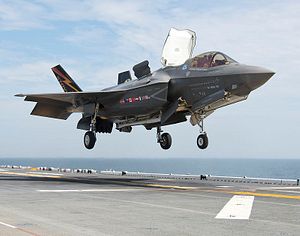On July 31, the outgoing commander of the U.S. Marine Corps, General Joseph Dunford, announced that the Marine Corps’ version of the supersonic fifth-generation F-35 Joint Strike Fighter achieved initial operational capability (IOC), Defense News reports.
“I am pleased to announce that VMFA-121 [Marine Fighter Attack Squadron 121] has achieved initial operational capability in the F-35B, as defined by requirements outlined in the June 2014 Joint Report to Congressional Defense Committees,” said General Dunford in a statement. “VMFA-121 has ten aircraft in the Block 2B configuration with the requisite performance envelope and weapons clearances, to include the training, sustainment capabilities, and infrastructure to deploy to an austere site or a ship.”
The ten F-35B — one of three designs of the multi-role fighter — of Marine Fighter Attack Squadron 121 (VMFA-121), based in Yuma, Arizona, were cleared for worldwide deployment after a five-day Operational Readiness Inspection. This was preceded by seven weeks of sea trials, according to Dunford. The unit “is capable of conducting close air support, offensive and defensive counter air, air interdiction, assault support escort and armed reconnaissance as part of a Marine Air Ground Task Force, or in support of the Joint Force,” Dunford said in the statement. VMFA-121 is scheduled to deploy to Iwakuni, Japan in 2017.
Dunford also boasted that the F-35 “will transform the way we fight and win.” However, the jets “are not in their final form. More capability, including the use of the plane’s gun, will come down the line with software update 3F, which will drop in 2017,” Defense News cautions. According to the “Defense Acquisition Acronyms and Terms Glossary,” initial operational capability is “attained when some units and/or organizations in the force structure scheduled to receive a system have received it and have the ability to employ and maintain it.”
The U.S. Marine Corps plans to purchase 420 F-35 aircraft, including 340 F-35B and 80 F-35C models, the plane’s carrier variant. The F-35B variant is capable of vertical or short takeoffs and vertical landings without requiring a catapult launcher, thanks to a lift fan and a directed thruster.
Over at Foxtrot Alpha, Tyler Rogoway neatly summarized why the F-35B is perhaps the most relevant F-35 variant when it comes to the the future projection of American air power in Asia:
The uber-complex F-35B, with its unique capability to takeoff and land in short distances, while retaining a decent majority of the conventional F-35A’s range and payload, is really a fantastic capability that makes this particular model of the Joint Strike Fighter the most strategically relevant out of the three variants.
The short takeoff and vertical landing optimized F-35B is so capable because its close relatives, the USAF’s conventional runway operated F-35A and the Navy’s catapult and arresting gear (“cat and trap”) configured F-35C, paid a huge price aerodynamically and conceptually in order to include the short takeoff and vertical landing (STOVL) requirement into the Joint Strike Fighter’s basic design. (…)
[S]ome would say that the F-35 was built as a STOVL [short takeoff and vertical landing] aircraft first, and then adapted to a standard and carrier fighter second, instead of the other way around.

































